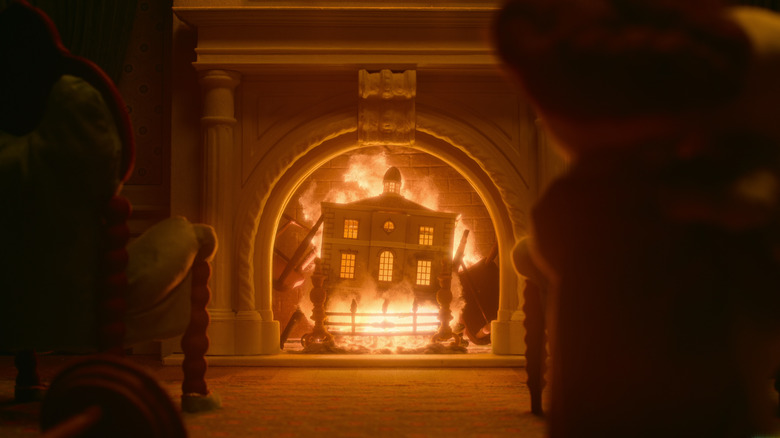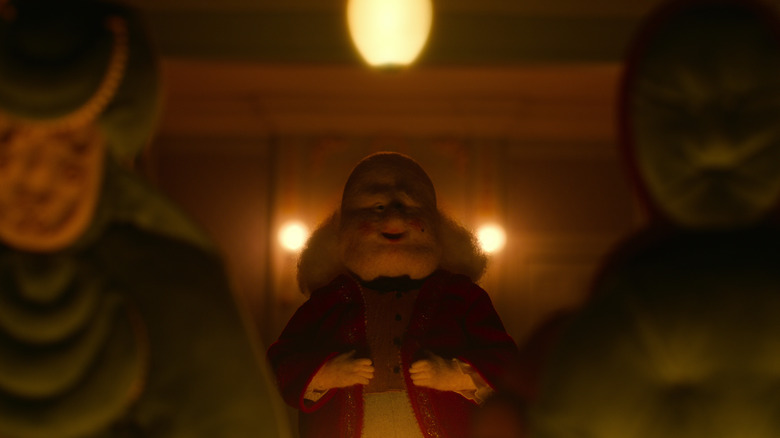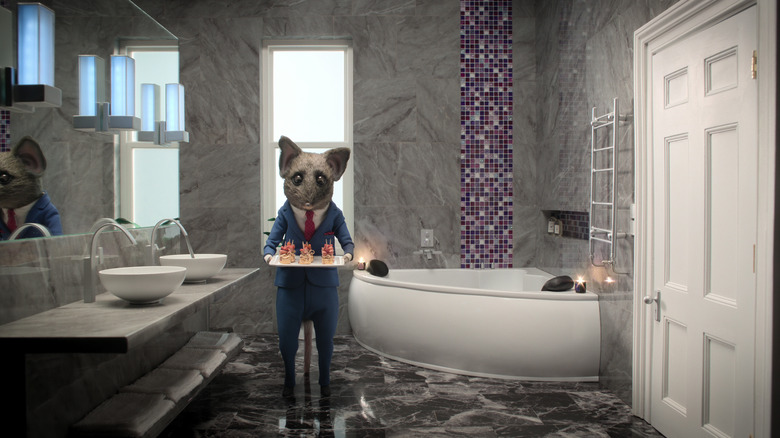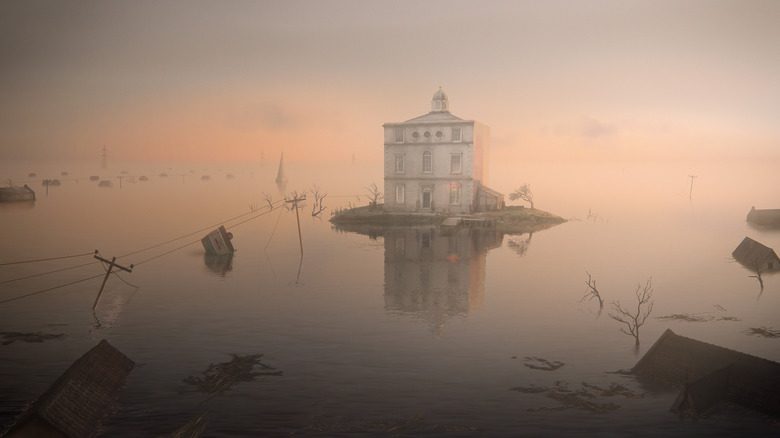The House Review: A Creepy, Strange, And Ultimately Beautiful Stop-Motion Anthology
What lurks in "The House"? This utterly enchanting, frequently disturbing stop-motion anthology arrives on Netflix today, and while the year just started, I think it just might be the first great movie of 2022. Hyperbole? Perhaps. But when a film comes along from seemingly nowhere and bewitches me so, I get excited. Featuring three wholly unique tales from different directors, "The House" exists in some kind of netherworld. It's like a series of stories trapped in some dusty picture book tucked away on a shelf in a haunted mansion, waiting to be pulled down and read by a crackling fire. It's creepy, strange, and, in the end, altogether lovely.
Is anything here real? Or a dream? Or a nightmare? It doesn't matter. What matters is the way the film carries you along, gently taking your hand and leading you down dark, ominous corridors. The stop-motion is hypnotic — the characters never quite look real, and they don't have to. The human figures look like strange rag dolls, the fabric of their skin quite noticeable, and the animals look like taxidermy that has suddenly sprung back to life, escaping whatever mounting previously held them. It all sends out a message that anything, literally anything, is possible. It's easy to get enchanted with it all.
Chapter 1
The first story, helmed by Emma de Swaef & Marc James Roels, concerns a poor but seemingly happy family living in a modest cottage sometime in the 1800s. These are the human characters — two parents, and new baby, and a young girl named Mabel (voiced by Mia Goth). After a strange night wandering the woods, the family patriarch, Raymond (Matthew Goode), meets an odd little man, an architect who claims to be a family friend. The next day, the family is made a surprising offer: a brand new house, totally free. Raymond, who bristles at his low standing in life, thinks this is a great idea. So does his wife. Only Mabel seems a bit perturbed by this all.
That uneasy feeling increases when they move into the house — which is built rather quickly, all things considered. The house itself is big and aesthetically pleasing. But the caveats begin almost immediately: when the family tries to move some of their furniture into the home, they're told they have to leave them behind — the architect furnished the house himself, and he wants no outside items. This may sound outlandish but it reminded me of a story I once heard about Frank Lloyd Wright, who designed not just the outsides of his houses but the insides, too, including the furniture, and where it should be placed. The story goes that Wright was prone to randomly show up unannounced at the houses he built and insist on coming in. The owner would oblige. If Wright saw a piece of furniture in a place where he hadn't intended it to be he would immediately push it back into its correct place. Perhaps the story is apocryphal. Perhaps not.
Once in the house, things get even weirder. The parents seem completely lost in a trance; the staircase to get upstairs suddenly disappeared; and try as he might, Raymond just can't get a fire started in the hearth. And oh yeah, that mysterious architect is fond of appearing seemingly out of nowhere and cackling to himself. Again, only Mabel senses something is amiss here — and she knows she has to get the heck out of the house with her baby sister in tow.
The rag-doll people who inhabit this story are both real and unreal. Again, it's as if some strange enchantment has been placed over this entire movie, animating the inanimate. Goth's sweet, soft voice performance anchors it all, the lone light shining in the darkness. And things only get weirder from here.
Chapter 2
The second story, directed by Niki Lindroth von Bahr, jumps forward to the present day. But instead of human characters, all the characters here are animals, even though they all seem to be occupying the same house. And I don't mean they're little animals scurrying about the floorboards — if this is indeed the same house, that means the creatures who now set foot in it are huge; human-sized. Here we meet a rat known only as the Developer (voiced by Jarvis Cocker). He's purchased the house, fixed it up, and plans on flipping it for a windfall. But that's not going to be so easy. For one thing, the house is infested with bugs – bugs who get their own big Busby Berkeley-style musical number beneath the sink.
For another, after inviting people (er, I mean, animals) over for an open house, the Developer finds that one couple that just won't leave. They claim they want to buy the house, and the Developer is thrilled. But as the couple starts taking long baths and ignoring any of the Developer's pleas for payment it becomes clear that they have no intention of exchanging money — they just want to stay. There's a blanket of discomfort enveloping this segment, from the scurrying bugs to the flop-sweaty ways the poor, hapless Developer tries to first sell the house and then tries to get the squatting couple out. The open house sequence is particularly awkward, as the Developer lists all the house's many accouterments to a group of uncaring onlookers.
Chapter 3
While the first two segments lean into horror and the surreal, the final entry in "The House," from Paloma Baeza, finds a glimmer of hope lurking in all that darkness. It's now sometime in the future, and the world has been flooded (Due to climate change, perhaps? We're never really told why). The house still stands, jutting out of an island, seemingly adrift in all that water. And characters still inhabit its walls. The house is now the property of a cat named Rosa (Susan Wokoma), who uses the huge manse as an apartment building. Only two tenants are left — Jen (Helena Bonham Carter) and Elias (Will Sharpe), and the future seems bleak.
But Rosa has hope. She keeps fixing the house up, assuming that any day now more tenants will arrive, and she can turn the building into a profitable venture. She grew up in this house, she says, and she needs money to fix it back up. That's going to be a little difficult since Jen and Elias aren't exactly good at paying their rent. The solution: find new renters who will give Rosa the money she needs to restore the house. But Rosa seems to be borderline delusional — she won't let a little thing like the flooding of the entire world get in her way. Amid this darkly humorous tale is that little ember of hope I mentioned; the sense that, as oppressive and haunting as the house might be, there's still the chance of something better. Of breaking away from foundations and setting sail.
Each of these tales is rendered with meticulous care. The fur on the animals bristle; firelight dances off the flat, dull, tiny black eyes of the humans; mist rolls in and shrouds it all, and then rolls back out. Even if you fail to connect with the stories, you'll be awed by the artistry of it all; the feeling of magic. And not magic in the sense of some cheap trick pulled out by some two-bit con artist. We're talking real magic here. The type of magic that can make the world feel new again.
/Film Rating: 9 out of 10



